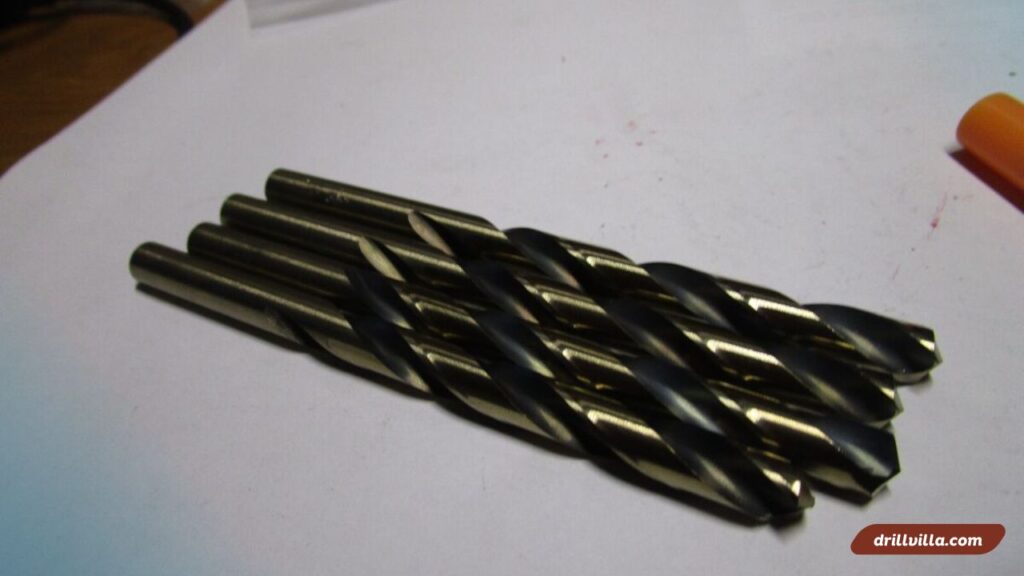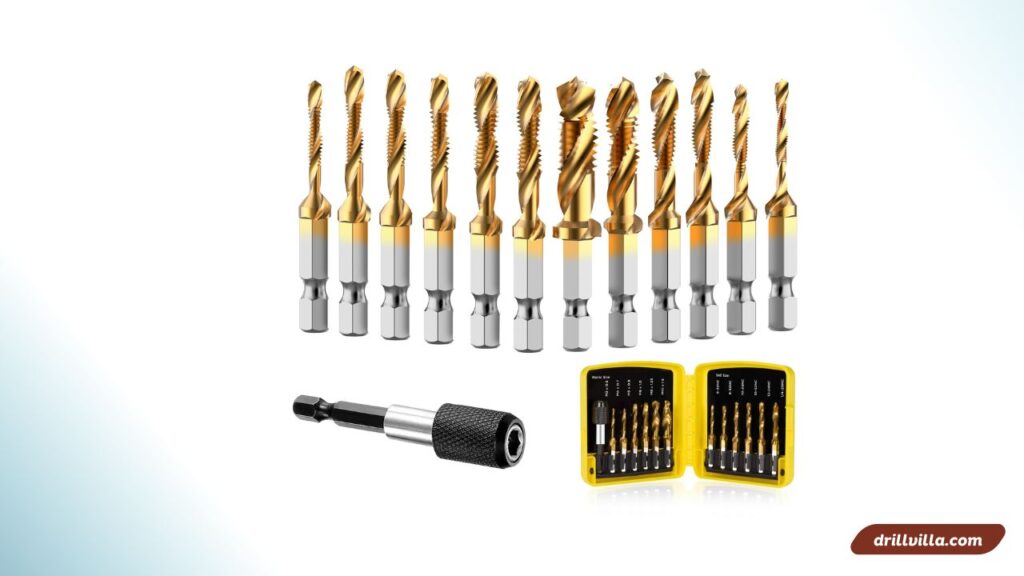Ever wondered what size drill bit for 3 8 16 tap? I’ve got the simple answer that saves time and broken taps—let’s drill smart, not hard!
So, you’re standing in your garage, tap set in hand, staring down a shiny 3/8-16 tap, wondering: “What size drill bit do I use for this?” Trust me, I’ve been there.
I still remember the first time I tried tapping threads into a chunk of aluminum for a DIY welding cart. I didn’t check the drill size, and let’s just say the tap didn’t survive. Since then, I’ve learned the hard way—and now I’m here to save you that headache.
Let’s dive in.
Article Summary
- What Is a 3/8-16 Tap, Anyway?
- So, What Size Drill Bit for 3/8-16 Tap?
- How I Learned the Importance of Using the Right Drill Bit
- Why the Drill Bit Size Matters
- Fractional vs. Letter vs. Number Drill Bits: What’s the Difference?
- What Materials Are You Tapping?
- Pro Tips for a Clean Tap Every Time
- What Happens If You Don’t Have a 5/16″ Drill Bit?
- Should You Use a Tapping Chart?
- What Size Drill Bit for 3 8 16 Tap Steel
- What Size Drill Bit for 3/8 NC16 Tap
- FAQs: What Size Drill Bit for 3/8-16 Tap?
- Final Thoughts: Trust the Chart, Trust the Process
What Is a 3/8-16 Tap, Anyway?
Before we even touch the drill bit, let’s get on the same page.
- 3/8 refers to the outer diameter of the screw (3/8 of an inch).
- 16 means there are 16 threads per inch (TPI).
- This is a coarse thread, one of the more common thread pitches for 3/8 size.
These threads are strong, and they’re usually used in medium-duty applications like metal frames, tool mounts, or car parts.

So, What Size Drill Bit for 3/8-16 Tap?
Here’s the straight-up answer:
You need a 5/16-inch drill bit for a 3/8-16 tap.
Yep, that’s it. Not 11/32, not 9mm. It’s 5/16″.
Let me break that down:
| Tap Size | Thread Count (TPI) | Drill Bit Size (inch) | Decimal Equivalent |
|---|---|---|---|
| 3/8-16 | 16 TPI | 5/16″ | 0.3125″ |
This size gives just the right amount of clearance for your threads to cut cleanly without weakening the material.
How I Learned the Importance of Using the Right Drill Bit
One time, I thought, “Hey, I don’t have a 5/16-inch bit, but 11/32 is close enough.” Big mistake. The threads were too shallow, and the bolt wobbled. I had to drill out the whole thing and start over with a thread insert. That added an hour to a job that should’ve taken ten minutes.
Moral of the story? Just use the right drill bit. Your tap (and sanity) will thank you.
Why the Drill Bit Size Matters
Imagine trying to carve a spiral groove into a log with a butter knife. That’s what tapping feels like if your pilot hole is too small. On the other hand, if the hole is too big, your threads won’t grab anything.
Too Small:
- Tap might break.
- Threads get stripped.
- You waste time and material.
Too Large:
- Threads are too shallow.
- Bolt won’t grip.
- May need a helicoil or thread repair kit.
So yes, that 5/16” size? It’s golden.
Fractional vs. Letter vs. Number Drill Bits: What’s the Difference?
If you’re new to tapping, you might see drill sizes in letters (like F or G) or numbers (like #7 or #9).
But for 3/8-16:
- Fractional: 5/16″ is perfect.
- Letter Size: Not needed here.
- Metric: 7.9mm or 8mm is close, but stick to 5/16″ for best results.
What Materials Are You Tapping?
This matters. A lot.
Soft Metals (Aluminum, Brass):
- Stick with 5/16″
- Go slow and use cutting fluid
Steel:
- Still 5/16″, but use a quality drill bit
- Use tapping oil or cutting fluid
Plastic or Wood:
- You can use 5/16″ or a tiny bit smaller
- Be gentle—it’s easy to over-thread these materials
Pro Tips for a Clean Tap Every Time
Here’s what I’ve picked up from dozens of tapping jobs:
- Always start with a center punch. This keeps your drill bit from walking.
- Use a drill press if you can. Helps keep the hole straight.
- Lubricate everything. I use cutting oil or even WD-40 in a pinch.
- Go slow. Rushing the tap is a one-way ticket to broken tools.
- Back it out every few turns. Clear out the chips and avoid jamming.
What Happens If You Don’t Have a 5/16″ Drill Bit?
Been there. If you’re desperate, here are close metric alternatives:
| Drill Size | Decimal (inches) | Difference |
|---|---|---|
| 7.9mm | 0.3110 | Slightly smaller |
| 8mm | 0.3149 | Slightly larger |
Use 7.9mm if you’re cautious. 8mm might make the threads loose, but it can work in non-critical applications.
Should You Use a Tapping Chart?
Absolutely. I keep one pinned up in my garage. It saves time and guesswork.
Here’s a simple chart reference:
| Tap Size | TPI | Drill Bit | Drill Type |
|---|---|---|---|
| 1/4-20 | 20 | #7 (0.201″) | Number Drill |
| 5/16-18 | 18 | F (0.257″) | Letter Drill |
| 3/8-16 | 16 | 5/16″ (0.3125″) | Fractional |
You can find printable charts online or apps that make this super easy.

What Size Drill Bit for 3 8 16 Tap Steel
Let me tell you, tapping steel is no joke. The first time I did it, I didn’t choose the right drill bit, and the tap snapped halfway in. I learned the hard way, so you don’t have to.
For a 3/8-16 tap in steel, the right drill bit size is 5/16 inch.
It’s the sweet spot. Big enough to keep the tap from binding, but small enough to hold the threads tight.
Why 5/16″ Works for Steel
Steel is tough. It pushes back. If you drill too small, the tap will fight you. If you go too big, the threads won’t grab right. The 5/16″ bit gives you:
- Clean threads
- Less risk of snapping the tap
- Strong hold when you’re done
I once tried using a smaller bit, thinking tighter threads would be better. Big mistake. The tap started to bind, and I had to back it out every half turn. It took forever, and the threads came out ugly.
Now, I always use 5/16″ when tapping 3/8-16 in steel, and it works like a charm every time.
Pro Tips When Drilling Steel
Here’s what helps me when tapping steel:
- Use cutting oil. It keeps things cool and smooth.
- Drill slow. Let the bit do the work.
- Back the tap out often. Every full turn, I reverse half a turn to break chips.
- Clamp your work. I learned not to hold it with my hand after a small slip cost me a bandage.
When you’re working with steel, you need to be careful. But when you use the right drill bit size, like 5/16″ for a 3/8-16 tap, you’ll have way fewer problems.
What Size Drill Bit for 3/8 NC16 Tap
Okay, so if you’ve seen “NC” in your tap set, don’t worry. It stands for National Coarse threads. A 3/8 NC16 tap is just another way to say 3/8-16 tap.
And yep, the drill bit size stays the same: 5/16 inch.
Why It’s Still 5/16″
Even if it says NC, nothing changes. NC threads are spaced wider than NF (National Fine), but that’s built into the tap. Your drill bit still needs to clear the center core, and 5/16″ does that best.
I’ve used this size for wood, aluminum, steel—you name it. And every time I see “3/8 NC16,” I just grab my 5/16″ bit and go.
When I Didn’t Know NC Meant the Same
I remember once, early on, I got confused seeing “NC.” I thought maybe I needed a special drill bit or something. I searched online, asked around, even bought a fancy chart. Guess what it told me?
Still 5/16″.
So now when I see “3/8 NC16,” I don’t even blink. I know exactly what to use.
Quick Table: NC Tap Drill Sizes
| Tap Size | Thread Pitch | Drill Bit Size |
|---|---|---|
| 1/4″-20 NC | 20 TPI | 13/64″ |
| 3/8″-16 NC | 16 TPI | 5/16″ |
| 1/2″-13 NC | 13 TPI | 27/64″ |
If you’ve got a 3/8 NC16 tap, you’re in the clear. Just grab your 5/16” bit, drill it clean, and tap away.
FAQs: What Size Drill Bit for 3/8-16 Tap?
Can I use an 8mm drill bit for a 3/8-16 tap?
Yes, but it’s slightly larger. Threads might be looser than ideal.
What is the tap drill formula?
The general formula is: Drill Size = Major Diameter – (1 / Threads per Inch)
So for 3/8-16:
= 0.375 – (1/16) = 0.3125 or 5/16″
Can I use a cordless drill?
Yes, but use a low speed and make sure to drill straight.
Is lubrication really necessary?
100% yes. It prolongs tool life and makes cleaner threads.
Where can I find a 5/16 drill bit?
Most hardware stores, Amazon, or even Harbor Freight. I keep a backup just in case.
Final Thoughts: Trust the Chart, Trust the Process
If you take one thing away from this article, it’s this:
When tapping a 3/8-16 thread, always use a 5/16-inch drill bit.
Don’t guess. Don’t improvise. It’s not worth the frustration or the broken tap. Keep a decent tap and drill set handy, and you’ll be golden.
I hope my mistakes save you time, money, and headaches. If you’re unsure about other tap sizes, let me know. I’ve probably messed them up before too—and learned something in the process.
Know More:
- How Much Does It Cost To Drill A Bowling Ball?
- What Size Drill Bit for 10 Screw
- Are You Supposed To Submerge Powered Orthopedic Drills For Decontamination?
- A 135 Split Point Cobalt Letter Drill Bits?
- How Long Does It Take to Drill a Water Well?
- What Type of Drill Bits Won’t Snap?
- What Are the Best Drill Bits for Stainless Steel?